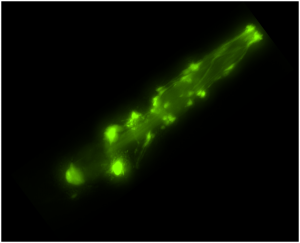Our lab is interested in understanding how neuronal signal transduction pathways regulate neurotransmitter secretion and how this impacts the function of underlying neuronal circuits that control behavioral output. Our lab uses C. elegans as a model organism for studying neuronal function, because of its simple neuronal circuitry, the ability to visualize synapses by fluorescent imaging in live animals, and its powerful genetics. We combine state of-the-art behavioral, genetic, cell biological, and in vivo neuronal imaging techniques in to study the cellular molecular mechanisms underlying secretion of neurotransmitter from synaptic vesicles and dense core vesicles. The lab is interested in three major areas:
1) What are the molecular mechanisms underlying the regulation of neuropeptide storage and secretion from neurons?
2) What are the mechanisms by which oxidative stress regulates neurotransmitter secretion and stress responses?
3) How does sphingolipid signaling control mitochondrial homeostasis in response to neuronal stress?
Many of the genes we study are conserved in mammals, so our studies provide novel insight into the mechanisms by which  neurotransmitter secretion may be regulated in humans.
neurotransmitter secretion may be regulated in humans.







